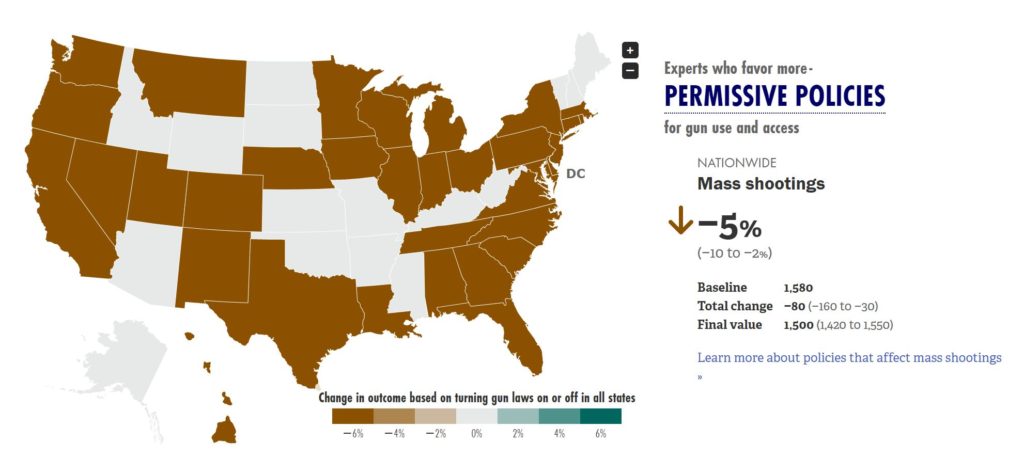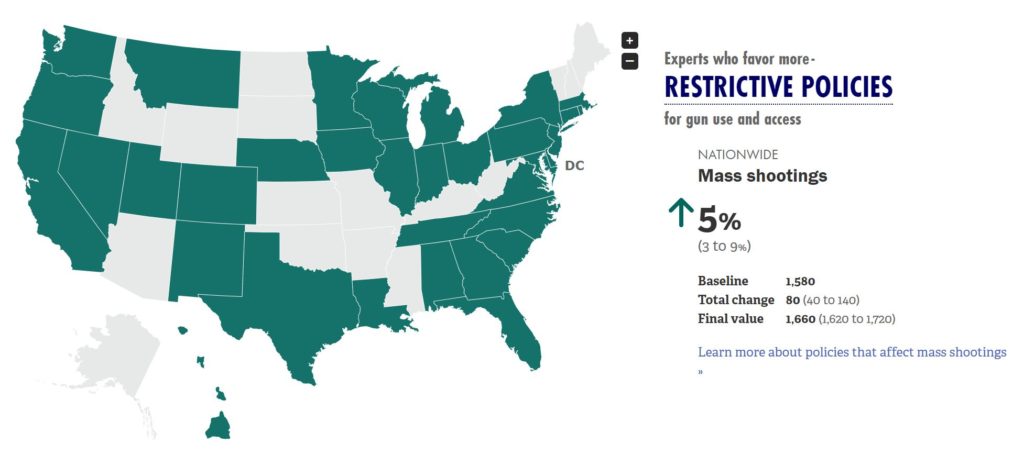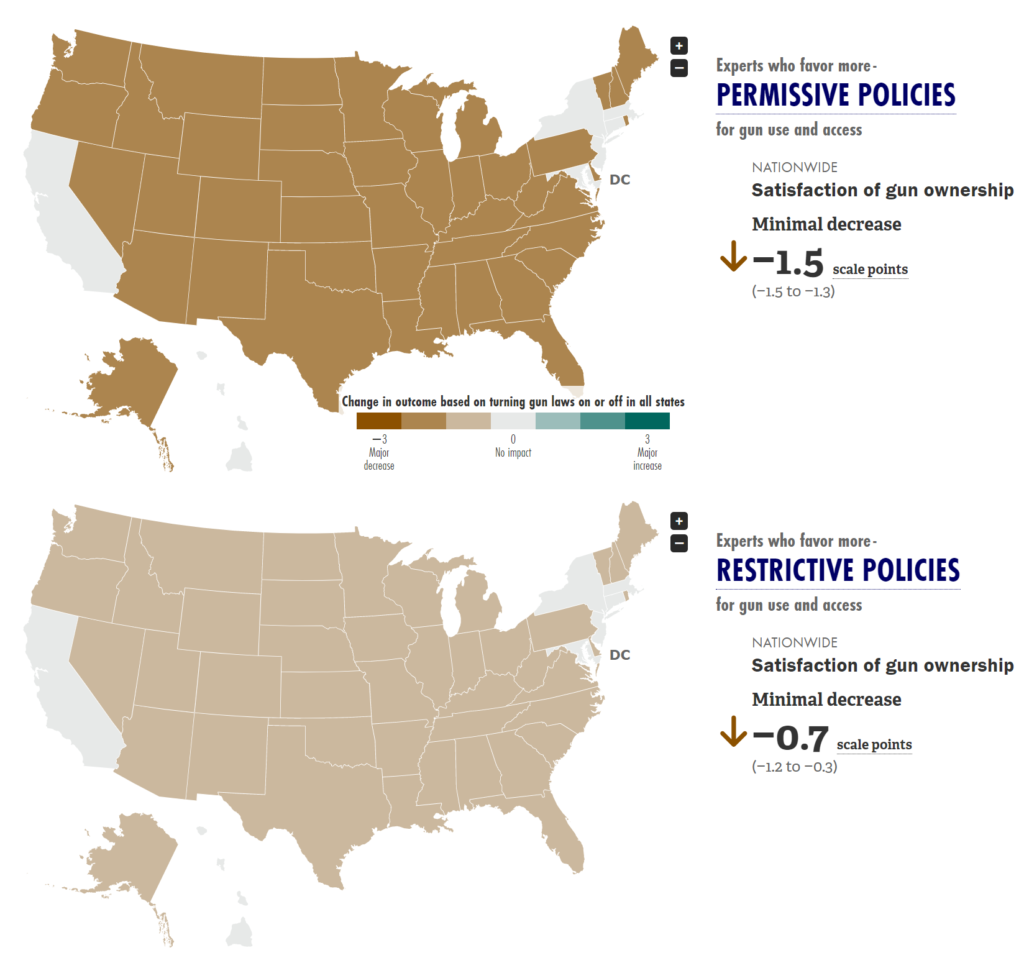Are gun policies really working in America? According to the Gun Policy Outcome Explorer by the RAND Corporation, it depends on who you ask.
While gun possession is largely (and constitutionally) protected in the United States, the often tragic results of such possession – firearm homicides, murders, mass shootings — aren’t always discussed equally. And depending on what side of the political isle you fall on, the conversation usually boils down to two opposing viewpoints– those who say more guns will save lines, and those that say less guns will save lives.
Find more interactive tools here!
Using The Gun Policy Outcome Explorer
Scientific research is often sparse and inconclusive when it comes to gun control. This, RAND argues, is why it’s important to consult “experts’ informed judgements” about the issue.
The Gun Policy Outcome Explorer does just that.
Asking a variety of questions on gun policy, RAND surveyed some 95 gun policy experts and recorded their responses on what they believed the effects and consequences of repealing or enacting gun laws (at the state level).
Of those surveyed by RAND, 79 experts favored more-restrictive approaches and 16 experts favored more-permissive approaches to how they would regulate guns (If you want to see their methodology, find it here).
In other words, use the tool to see where experts agree and disagree on a number of gun laws. Or use a combination of policies to see where there’s potential for agreement.
Here’s how to use it!
Step 1: Toggle Laws On And Off
Select a state law and toggle it on or off. You can select multiple options or just one. Turning a state law “on” will enact it in every state; turning a state law “off” will repeal it in the states where the law is currently in place.
Here are the selectable options:
- 10-day waiting period to purchase a firearm
- Child-access prevention laws
- Ban on the sale of assault weapons and high-capacity magazines
- Child-access prevention media campaigns
- Elimination of gun-free zones
- Expanded mental health prohibitions
- Stand-your-ground laws
- Universal background checks
- Firearm and ammunition taxes
- Lost or stolen firearm reporting requirements
- Minimum age requirements
- Permitless carry
- Requiring a license to purchase or possess firearms or ammunition
- Requiring firearm sales to be reported and recorded
- Surrender of firearms by prohibited possessors
Step 2: Select An Outcome To see If Gun Policies Are Really Working
After toggling a state law to on, select an outcome to compare expert opinions. Choose from 9 quantitative outcomes and 3 qualitative outcomes.
- Quantitative Outcomes
- Sale of New Firearms
- Hunting Participation
- Firearm Suicides
- Mass Shootings
- Property Crime
- Other Violent Crime
- Defensive Gun Use
- Unintentional Firearm Deaths
- Qualitative Outcomes
- Right to Bear Arms
- Privacy Rights
- Satisfaction Of Gun Ownership
Step 3: See If Experts Think Gun Policies Are Really Working
After selecting an outcome, you’ll notice that the right side has two separate maps. The top map highlights “experts who favor more permissive policies for gun use and access” and the bottoms map highlights “experts who favor more restrictive policies for gun use and access.”
Here’s our example after toggling on “permitless carry” and selecting “mass shootings” as an outcome.

For the example above, you’ll notice that the experts who favor more permissive policies for gun use and access believe that the “permitless cary” will result in lower mass shootings nationwide.
For the example below, you’ll notice that experts who favor more restrictive policies for gun use and access believe that “permitless carry” will increase mass shootings nationwide.

You Can Also See Qualitative Outcomes
If you want to see qualitative outcomes, look towards the bottom left of the screen and click on one of three options:
- Right to Bear Arms
- Privacy Rights
- Satisfaction Of Gun Ownership
For the example below, we’ve turned on “Ban on the sale of assault weapons and high-capacity magazines” and have selected “Satisfaction of Gun Ownership” as an outcome.
You’ll notice that those who favor more permissive policies for gun use and access believe that a ban on assault weapons will have a minimal decrease in gun owner satisfaction.
Those that favor more restrictive policies for gun use and access believe that a ban on assault weapons will still have a minimal decrease, but less so than than the aforementioned group.

More Findings
If you want to explore additional information on gun control policies and outcomes, consider reading “7 facts about guns in the U.S.” from the Pew Research Center.
Some Quick Facts From The Pew Research Center Article
According to this survey (conducted in March and April 2017), four-in-ten U.S. adults report living in a household with a gun, thirty percent of Americans say they own a gun personally, and 11% say they live with someone who owns a gun.
American exposure to guns is also quite significant. Almost half of U.S. adults said they grew up in a gun-owning household, just under 60% said they had friends who own guns, and the vast majority (approximately 72%) have fired a gun before.
Even more interesting, is that most people who do own a gun, typically own more than one. Among all these owners, 66% said they own more than one gun and 29% own five or more. Of all these owners, 72% own a handgun and 62% own a rifle, and 54% own a shotgun.
Why Do People Own Guns
Most owners say it’s for protection. Of all of those surveyed by the Pew Research Center, 67% said it was for protection, 29% said it was for hunting, 30% for sport shooting, 13% for gun collecting, and 8% for their job. Higher shares of women were more likely to say that they owned a gun for protection while a higher share of males were more likely to say that it was for hunting.